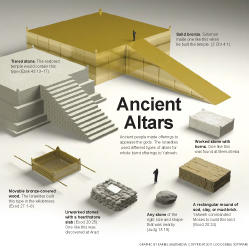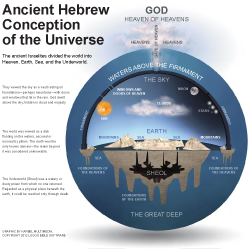9:1–10 The fifth vision report (vv. 1–4) consists of Amos’ vision of Yahweh, who describes in detail how thoroughly He will exact judgment on Israel. To emphasize the totality of Yahweh’s sovereignty, the imagery employs several merisms—figures of speech that use two components to refer to a whole (e.g., “from head to toe” describes the entire body). Amos follows this report with another hymnic interruption (vv. 5–6), as if the wrathful rhetoric of the vision report needed to be placed in context of the wrath of the Creator of the cosmos, who can do as He pleases with His creation. Yahweh declares His concern for His people and that He will punish them for their sin (vv. 7–10). |
9:1 Lord standing by the altar Amos offers no further detail about the location of this altar. He could be at the shrine in Bethel, about to destroy it. Alternatively, Yahweh could be in His heavenly palace, after which the earthly temples were modeled, or He could be in His earthly dwelling at the Jerusalem temple.
so that the thresholds will shake An image of destruction for a temple or palace. The tops of the pillars are often called “capitals” (e.g., 1 Kgs 7:16), and the thresholds are the bottoms. The merism indicates the total destruction of the structure.
9:2 Sheol Refers to the underworld. See note on Gen 37:35. The contrast between this place (also called Sheol; see note on Gen 37:35) and heaven reinforces that there is nowhere for anyone to escape.
 Old Testament Theology of the Afterlife
Old Testament Theology of the Afterlife
9:3 Carmel A high mountain near the Mediterranean coast; see note on Amos 1:2. The merism between the mountain and the bottom of the sea emphasizes that there is no earthly hiding place to escape Yahweh.
9:4 for harm and not for good Yahweh’s wrath is not malevolent; it should be expected based on Israel’s failure to keep even the most basic aspects of the covenant (Deut 28:15–68).
9:5 it sinks down like the Nile of Egypt The Nile had an annual flood cycle. See Amos 8:8 and note.
9:6 the waters of the sea Compare 5:8.
9:7 not like the Cushites Yahweh reveals to Israel that, despite Israel’s election as His chosen people, He still cares for all people. The area south of Egypt was at the far end of the known world for the Israelites at this time. See note on Isa 18:1.
the Philistines from Caphtor and the Arameans from Kir Yahweh claims responsibility not only for the movement of Israel from Egypt to Canaan but also for the migrations of the Philistines and the Arameans (Syrians).
Caphtor Usually identified with Crete. See note on Jer 47:4.
Kir Likely a place in Mesopotamia.
9:8 I will not utterly destroy the house of Jacob Foreshadows the future restoration described in Amos 9:11–15.
the house of Jacob Refers to Israel.
9:11–15 Amos ends with a salvation oracle. He follows the pattern of Hosea and Joel by ending with a vision of an ideal future in which Israel is restored and the broken relationship with Yahweh is repaired. |
9:11 On that day Points to the day of salvation. See note on Isa 27:12.
the booth of David Reminds Israel, which had rejected the Davidic dynasty, of Yahweh’s promises to David.
9:12 the remnant of Edom Compare Obad 19.
9:13 the one who plows will overtake the one who reaps The imagery here is of a blessed creation where the land is continually fertile and the growing season is continuous. As soon as the harvest is complete, the land can be plowed to plant again.
the mountains will drip sweet wine Compare Joel 3:18.
9:14 I will restore the fortunes of my people Israel The restoration involves the reversal of the curses about vineyards and houses (Amos 5:11). See note on Jer 29:14.

|
About Faithlife Study BibleFaithlife Study Bible (FSB) is your guide to the ancient world of the Old and New Testaments, with study notes and articles that draw from a wide range of academic research. FSB helps you learn how to think about interpretation methods and issues so that you can gain a deeper understanding of the text. |
| Copyright |
Copyright 2012 Logos Bible Software. |
| Support Info | fsb |
 Loading…
Loading…


